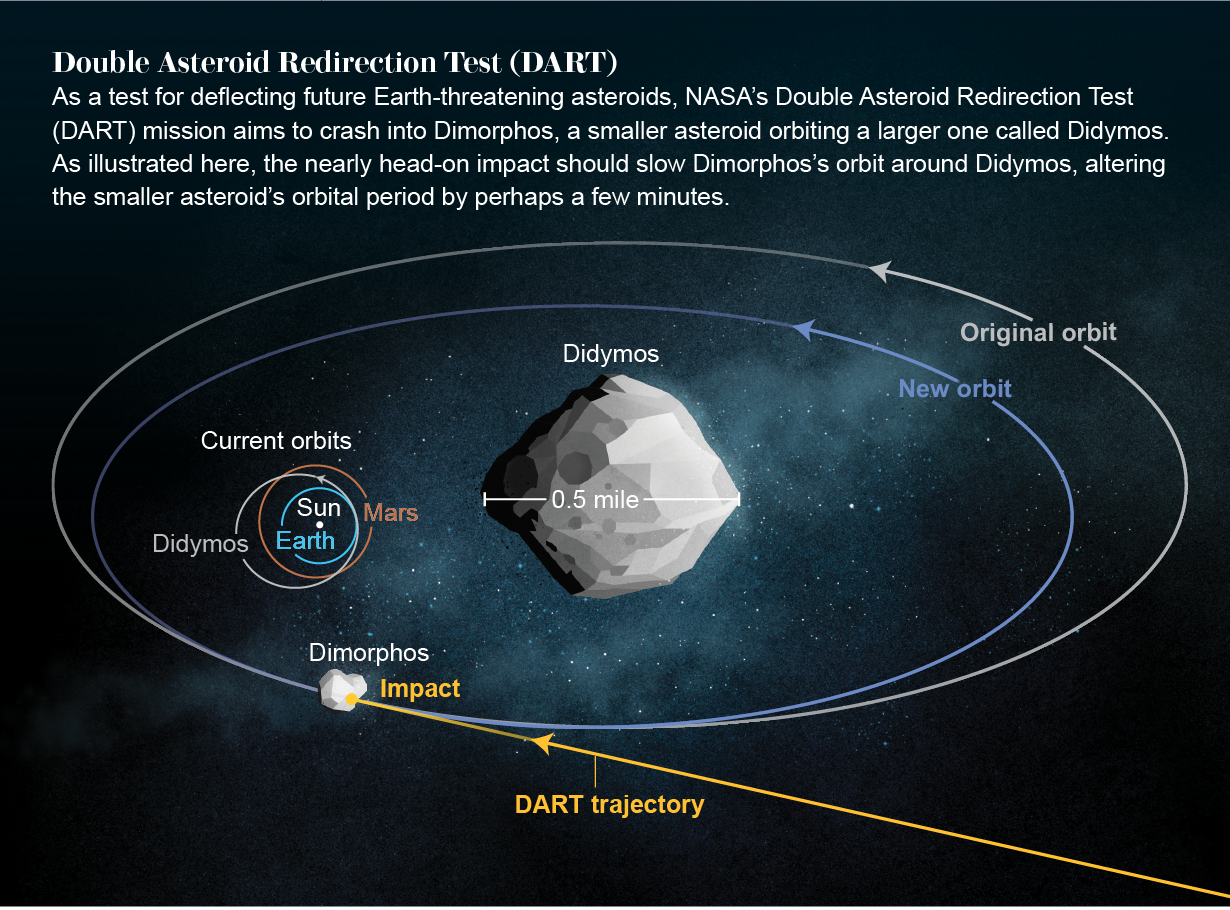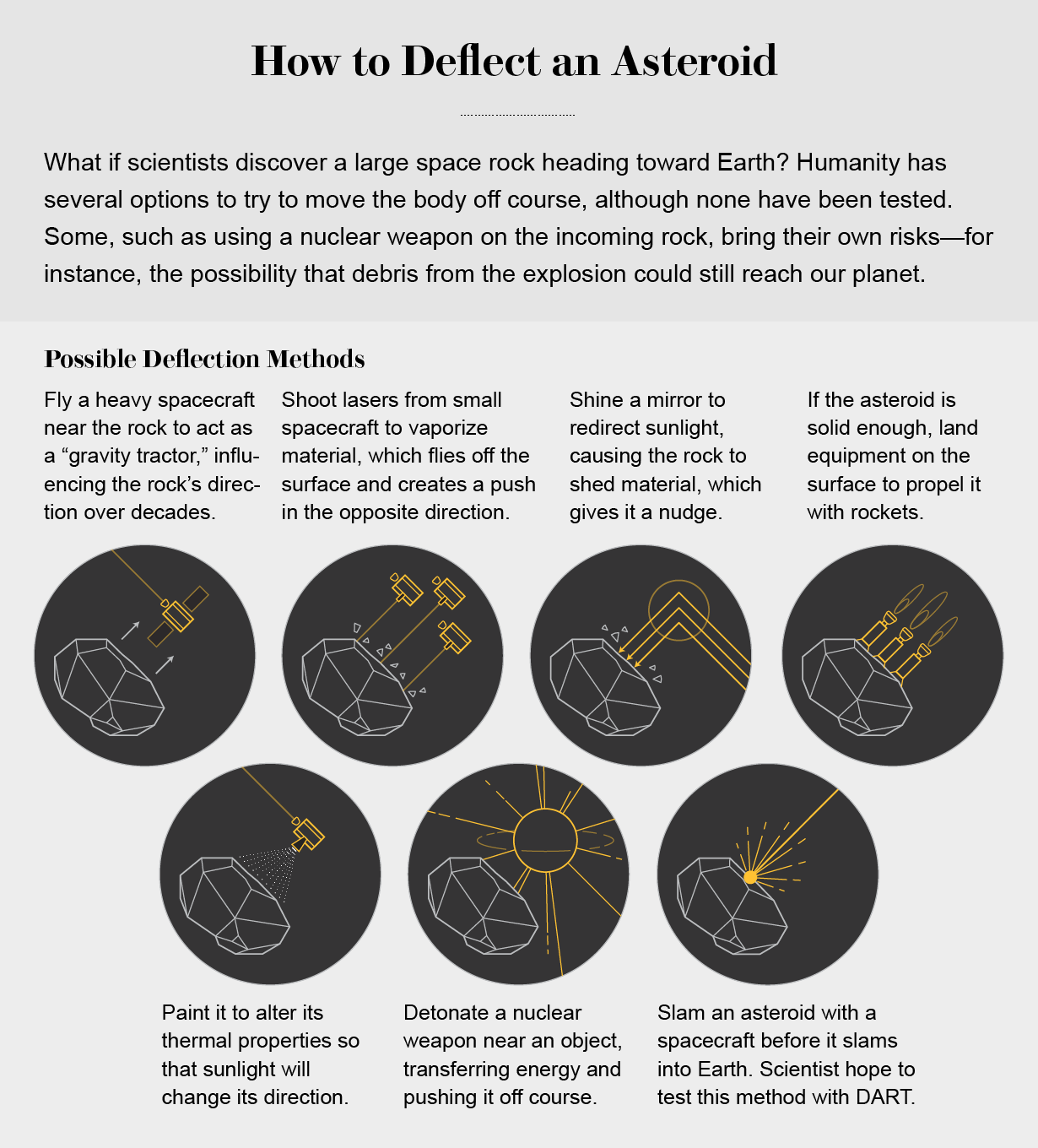An asteroid wiped out the dinosaurs; now Earthlings are fighting back. The sight of saurian fossils in most any science museum is a potent reminder that asteroids can threaten Earth as they swing around our sun, occasionally coming dangerously close to our planet—or, 66 million years ago, too close. Now scientists have tested a method that might save our planet from future doomsdays. In the past hour, NASA’s Double Asteroid Redirection Test (DART) spacecraft crashed into a small asteroid called Dimorphos.
As DART’s full name implies, this impact was no accident. It’s meant to shift the space rock’s trajectory by a tiny but noticeable amount—a change that observers will carefully confirm and track from afar with a plethora of ground- and space-based telescopes. In the future, if a dangerous asteroid is found on a collision course with Earth, we might use this same technique to nudge it off course and avert disaster. “We’re not blowing up the Death Star,” says Andy Rivkin, DART investigation team lead at the Johns Hopkins University Applied Physics Laboratory (APL), which runs the mission. “We’re using the momentum from the spacecraft to change the orbit of the asteroid.”
DART launched in November 2021 on a collision course with Dimorphos, a small asteroid 160 meters in size that orbits another asteroid, Didymos, that is almost five times larger. Over nearly a year the vending-machine-sized, circa 600-kilogram spacecraft caught up to the asteroids, taking ever sharper images as it approached. That was until today, at 7:15 P.M. ET, when engineers at APL’s mission control stopped receiving signals from the spacecraft, confirming its self-destructive slam into Dimorphos about 11 million kilometers from Earth.
“We are embarking on a new era for humankind,” said Lori Glaze, director of NASA’s planetary science division, in post-impact remarks during the space agency’s livestream of the event. “An era in which we have the potential capability to protect ourselves from something like a dangerous asteroid impact.”
Traveling at about 23,000 kilometers per hour, the spacecraft hit the asteroid with the approximate energy of three metric tons of TNT, exploding in a superheated shower of metal and asteroid debris. A small Italian spacecraft called LICIACube (Light Italian Cubesat for Imaging of Asteroids) following three minutes behind took images of the impact that will be released in the coming days. Yet the true mission has just begun. Now scientists will watch Dimorphos with everything from ground-based telescopes to deep-space observatories and see exactly how much of an effect DART’s dramatic impact had on its target. “We’re demonstrating for the first time that if humanity needed to alter the course of an asteroid, we would be capable of doing that,” says Harrison Agrusa of the University of Maryland, a member of the DART team.
The DART mission was originally conceived some two decades ago, when scientists in the U.S. and Europe began to discuss a joint mission that could practice a kinetic asteroid deflection technique. Originally called AIDA (Asteroid Impact and Deflection Assessment), the mission would involve NASA’s DART spacecraft and Europe’s AIM (Asteroid Impact Mission) spacecraft, which would orbit the target and watch the impact. Sadly, European officials canceled AIM in 2016 because of a lack of funding. In 2019, however, the mission was reborn as the Hera spacecraft (named for the Greek goddess of marriage). But that reset in development meant a delayed launch: Hera won’t lift off until 2024 and won’t arrive at Didymos until 2026—much too late to witness DART’s impact but still in time to study its enduring effects.
Scientists wanted DART’s target to be a binary asteroid, where one asteroid orbits another, because such celestial configurations allow easier measurements of small, impact-induced orbital changes. “The deflection is almost instantaneous,” says Patrick Michel of the French National Center for Scientific Research, former lead scientist of AIM and now principal investigator of Hera. In 2013 scientists selected the Didymos system as the target. First found in 1996, that larger asteroid gained its name (Greek for “twin”) following the discovery of a small orbiting companion in 2003, which was later dubbed Dimorphos, or “to have two forms.”

Dimorphos completes an orbit of Didymos every 11.92 hours. The asteroids share a similar orbit with Earth yet pose no threat as they never come closer than a few million kilometers to our planet. But their angle of orbit means that Dimorphos regularly “eclipses” in front of Didymos, allowing its orbital period to be precisely measured. Following the impact, a variety of telescopes, including the James Webb Space Telescope and Hubble—and even spacecraft such as NASA’s Lucy probe, which is currently on its way to visit asteroids near Jupiter—will track this eclipse, allowing scientists to work out just how much Dimorphos’s orbit has been changed.
DART hit the asteroid nearly head on, meaning it slowed Dimorphos’s orbit. The asteroid is so small, however, that mission scientists knew neither its exact shape nor its composition—whether Dimorphos was a rigid and solid object or rather a looser “rubble pile” of rocks and boulders that have gently accumulated together. During the final moments of its approach, DART beamed back images of Dimorphos’s rubble-strewn surface, indicating the asteroid was far from rock-solid. If it had been, the change in its orbit could have been barely more than a minute, as DART would have transferred only a relatively small amount of momentum to the asteroid. “We need at least 73 seconds of orbit change” for the mission to be heralded a success, Rivkin says. Instead, Dimorphos’s shabby appearance suggests the force of outward-spewing material (perhaps as much as a few tens of millions of kilograms) could cause a much larger shift in momentum, shortening the asteroid’s orbit by 10 minutes or more. Such an event could completely reshape Dimorphos or even send it tumbling head over heels. “The weaker the asteroid, the larger the crater,” says Sabina Raducan of the University of Bern in Switzerland, a DART team member. “Of course, we want there to be a lot of deflection and ejecta because that’s more interesting.”

Observations by telescopes and LICIACube should reveal roughly how much the orbit changed and how much ejecta was released, with the DART team set to announce preliminary results from the mission this December at a meeting of the American Geophysical Union in Chicago. But no one will know for certain how successful the mission was until Hera arrives in 2026. That spacecraft’s observations will accurately measure the mass of Dimorphos and get a more exact sense of how much its orbit has changed around Didymos, perhaps 10 times better than would otherwise be possible from more remote observations alone. “We’ll understand how big the push was and get a better understanding of what Dimorphos is made of,” says Angela Stickle of APL, a DART team member.
That could be crucial information if something like DART is ever called on to save Earth in the future. “This is one of the most important things we’re doing at the moment,” says Detlef Koschny, deputy head of ESA’s Planetary Defense Office. “We’ve been talking about the need to demonstrate that we can deflect an asteroid for many years.” While no dinosaur-killer asteroids of several kilometers in size are known to be on an impact course with our planet, smaller asteroids like Dimorphos are less well constrained, with only an estimated few percent of their total population currently known. “We don’t yet know enough to feel safe,” Koschny says. An impact by a Dimorphos-sized space rock could instantly obliterate a city and cause widespread damage to an entire country, meaning there is good reason to look out for such asteroids.
Upcoming telescopes, such as the Vera C. Rubin Observatory, set to come online in Chile later this decade, will better track these asteroids. If we ever do find one on a collision course with Earth, the outcomes of the DART mission may well dictate what action we take. “It is going to validate a tool that we could use,” Rivkin says. To divert a hazardous asteroid, perhaps a larger version of DART could be used or even a series of DART-sized spacecraft to slam into the offending space rock, one after another, incrementally deflecting its doom. “It depends on how much warning time we have,” Rivkin says. Such a perilous event is unlikely to befall humanity anytime soon. But perhaps, far in the future, our distant descendants will have this little spacecraft to thank. “If we can deflect Dimorphos, we can most likely deflect any other near-Earth asteroid,” Agrusa says.
